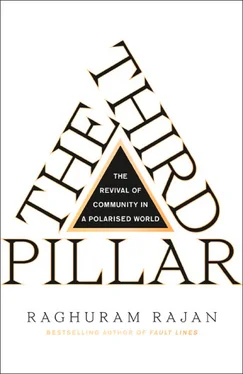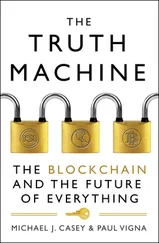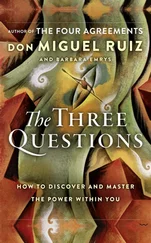Although no country can function if every community picks and chooses the laws they will obey, we will see that some decentralisation in legislative powers to the community can be beneficial, especially if there are large differences in opinion between communities.
A critical function the community plays in modern market democracies is to serve as a training ground for aspiring politicians – recall that Barack Obama was a community organiser – with the community itself constituting a ready-made structure for political mobilisation. Furthermore, it is community-based movements against corruption and cronyism that time and again prevent the leviathan of the state from getting too comfortable with the behemoth of big business. Indeed, as we will see in the book, healthy communities are essential for sustaining vibrant market democracies. This is perhaps why authoritarian movements like fascism and communism try to replace community consciousness with nationalist or proletarian consciousness.
In sum, the proximate community is still relevant today, even in cosmopolitan cities where ties of kinship and ethnicity are limited, and even in individualistic societies like those of the United States and Western Europe. Once we understand that the community matters, then it becomes clear why it is not enough for a country to experience strong economic growth – the professional economist’s favourite measure of economic performance. How that growth is distributed across communities in the country also matters immensely. People who value staying in their community are not very mobile. Since they cannot move to work where growth occurs, they need economic growth in their own community. If we care about the community, we need to care about the geographic distribution of growth.
What then is the source of today’s problems? In one word, imbalance! When the three pillars of society are appropriately balanced, society has the best chance of providing for the well-being of its people. The modern state provides physical security, as it always has, but also tries to ensure fairness in economic outcomes, which democracy demands. To do this, the state sets limits on the markets while also ensuring they offer people a level playing field. It also has to make sure that most people have the ability to participate on equal terms in the market, and are buffered against its fluctuations. The competitive markets ensure that those who succeed in it are efficient and produce the maximum output with the resources available. The successful have both wealth and some independence from the state, thus they have the ability to check arbitrary actions by the state. Finally, the people in industrial democracies, engaged in their communities and thereby organised socially and politically, maintain the necessary separation between markets and the state. By doing this they enable sufficient political and economic competition that the economy does not descend into cronyism or authoritarianism.
Society suffers when any of the pillars weakens or strengthens overly relative to the others. Too weak the markets and society becomes unproductive, too weak a community and society tends toward crony capitalism, too weak the state and society turns fearful and apathetic. Conversely, too much market and society becomes inequitable, too much community and society becomes static, and too much state and society becomes authoritarian. A balance is essential!
THE EFFECTS OF TRADE AND THE ICT REVOLUTION ON THE COMMUNITY
The pillars are seriously unbalanced today. The direct effects of the ICT revolution through automation, and the indirect but more localised effects through trade competition, have led to large job losses in some communities in developed countries. Typically, these have been middle-income jobs held by the moderately educated. With male workers least able to adjust, families have been tremendously stressed, with an increase in divorces, teenage pregnancies, and single-parent households. In turn, these have led to a deterioration in the environment for children, resulting in poor school performance; high dropout rates, the increased attractiveness of drugs, gangs, and crime; and persistent youth unemployment. Importantly, community decline tends to feed on itself, as still-functional families escape so that their children do not get affected by the unhealthy environment.
In the United States, minority and immigrant communities were hit first by joblessness, which led to their social breakdown in the 1970s and 1980s. In the last two decades, communities in small towns and semirural areas, typically white, have been experiencing a similar decline as large local manufacturers close down. The opioid epidemic is just one symptom of the hopelessness and despair that accompanies the social breakdown of once-healthy communities.
The technological revolution has been disruptive even outside economically distressed communities. It has increased the wage premium for those with better capabilities significantly, with the best employed by high-paying superstar firms that increasingly dominate a number of industries. This has put pressure on upper-middle-class parents to secede from economically mixed communities and move their children to schools in richer, healthier communities, where they will learn better with other well-supported children like themselves. The poorer working class are kept from following by the high cost of housing in the tonier neighbourhoods. Their communities deteriorate once again, this time because of the secession of the successful. Technological change has created that nirvana for the upper middle class, a meritocracy based on education and skills. Through the sorting of economic classes and the decline of the mixed community, however, it is also becoming a hereditary one, where only the children of the successful succeed.
The rest are left behind in declining communities, where it is harder for the young to learn what is needed for good jobs. Communities get trapped in vicious cycles where economic decline fuels social decline, which fuels further economic decline … The consequences are devastating. Alienated individuals, bereft of the hope that comes from being grounded in a healthy community, become prey to demagogues on both the extreme Right and Left, who cater to their worst prejudices. Populist politicians strike a receptive chord when they blame the upper-middle-class elite and establishment parties.
When the proximate community is dysfunctional, alienated individuals need some other way to channel their need to belong. 4Populist nationalism offers one such appealing vision of a larger purposeful imagined community – whether it is white majoritarianism in Europe and the United States, the Islamic Turkish nationalism of Turkey’s Justice and Development Party, or the Hindu nationalism of India’s Rashtriya Swayamsevak Sangh. 5It is populist in that it blames the corrupt elite for the condition of the people. It is nationalist (more precisely, ethnic nationalist, but I will leave the nitpicking for later) in that it anoints the native-born majority group in the country as the true inheritors of the country’s heritage and wealth. Populist nationalists identify minorities and immigrants – the favourites of the elite establishment – as usurpers, and blame foreign countries for keeping the nation down. These fabricated adversaries are necessary to the populist nationalist agenda, for there is often little else to tie the majority group together – it is not really based on any true sense of community, for the differences between various subgroups in the majority are usually substantial.
Populist nationalism will undermine the liberal market democratic system that has brought developed countries the prosperity they enjoy. Within countries, it will anoint some as full citizens and true inheritors of the nation’s patrimony while the rest are relegated to an unequal, second-class status. It risks closing global markets down just when these countries are aging and need both international demand for their products and young skilled immigrants to fill out their declining workforces. It is dangerous because it offers blame and no real solutions, it needs a constant stream of villains to keep its base energised, and it moves the world closer to conflict rather than cooperation on global problems. While the populist nationalists raise important questions, the world can ill afford their shortsighted solutions.
Читать дальше












